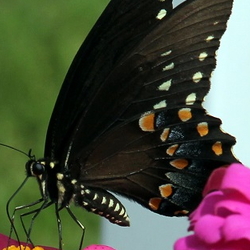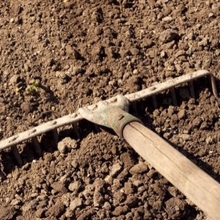I was not particularly fond of third grade. I had a new teacher and she was not impressed with the pokeberry juice on my hands or the burrs in my hair. I had taken a short cut to school, just to see if the pokeberries were ripe enough to make a really strong red dye, and then I walked too close to the burdock when I was trying to catch a yellow swallowtail. I really didn't understand what her problem was, my other teachers did not find fault with dyes on my hair and my hands, and they never said anything about any burrs that attached themselves to me. This was a new teacher, though, and for some reason she had her evil eye on me. She sent me home the first day with a comb for my hair and a note for my mother.
My mother was humiliated, and I had to wear french braids every day. French braids hurt and to this day I think that is why I have wrinkles in the outer corners of my eyes. I did not like my teacher, and she surely did not like me. I loved school up until that year, and I could not for the life of me figure out what I was doing wrong. The first paper we had to write was all about what we had done during the summer. I wrote and wrote, page after page, only to see C- on my story the next day. And beside the grade she had written: "I asked for the truth, I did not tell you to make up a story."
This time I went home humiliated. My mother read my story. I had written about climbing mountains in search of medicinal plants with my great Aunt Bett, I told how to make dyes from flowers and berries, I told how to make salves by using lard and beeswax. My mother saved that paper for me and I recently found it while searching for more Aunt Bett stories. I think it was about as good as anything else I have ever written. At the time, my mother tried to tell me to give it some time, until my teacher got to know me. I was seriously considering quitting school. I went to visit Aunt Bett and I told her my problem. I asked her if she knew of any medicine that would make me smart. She told me that it was the teacher who was at fault, and that made me feel a little better, but I still thought if I could just be smarter, she would like me a little bit. Aunt Bett didn't have smart medicine, she said.
Things went along with my teacher on one side of the line and me on the other, neither of us would give an inch. A little time passed and I happened to be with Aunt Bett when she was looking for a particular plant that she used to treat earaches. She told me she was looking for knotweed, but that some folks called it smartweed. My heart started pounding, "Smartweed," I said, "we are lookin' for smartweed?" I doubled my search efforts.
Smartweed, Persicaria hydropiper, has a name that is deceiving. It also has a very strange history. According to some herbalists, man has ascribed a strange assortment of powers to the plant, but not a one of them contribute to intelligence. A bit of smartweed tucked beneath the saddle was said to keep a horse from feeling hunger or thirst; strewing the plant on the floor was supposed to rid a room of fleas; and just a few drops of the juice reportedly destroyed the insidious worms that were believed to cause earaches. Cholera victims were sometimes wrapped in sheets that had been soaked in a brew made of boiled smartweed. The plant was also added to baths to help ease the pain of rheumatism. It has been called effective as a cure for everything from toothaches and epilepsy to gangreen and gout. Today smartweed is used in folk medicine as an external astringent, and a contraceptive. Because of its flavor, it is believed to have been used as a seasoning for food as long ago as prehistoric times.
It grows along stream banks and in ditches, preferring moist soils. It is common in North America except in the extreme south. it is an annual herb with reddish jointed stems that can reach 2 feet, and it has narrow lance-shaped leaves. Tiny greenish white, often red tipped flowers are borne on long, slender, drooping spikes. The flowers bloom from June to November. The plant also yields a golden yellow dye. Experiments indicate that extracts of smartweed have properties that help stop bleeding and lower blood pressure. Animal studies suggest the plant has contraceptive effects.
If you think I ate a smartweed plant, you would be right. I waited until I left Aunt Bett's and while I was walking home, I just knew I had time to eat the entire plant. I had thoughts of being positively brilliant by the next day. The looks of the small fragile plant are deceiving. Its acrid burning flavor causes a smarting sensation, very much like eating the hottest hot pepper. I thought it must have been the food that dragons ate, since in every dragon picture I ever saw fire was shooting out its mouth. I might have looked like that. I had crammed that entire weed into my mouth, and proceeded to chomp down, and down again before I realized that my mouth was on fire. I later found out that even livestock wouldn't touch the plant. I also found that some folks call it water pepper.
mouth was on fire. I later found out that even livestock wouldn't touch the plant. I also found that some folks call it water pepper.
So I was on my way home, chewing on the hottest thing I had ever had in my mouth. I was not supposed to ever taste the plants Aunt Bett worked with, and now not only had I broken a rule but I had probably killed myself in the process. There was no way I could tell my mother, there was never any sympathy when I broke a rule. I ran in the house and into the bathroom, racing to stick my head under the faucet. Somehow I survived, and let me assure you, I gained not an ounce of higher intelligence. My third grade was a most miserable year. I still don't understand why somebody named it smart weed, but my friend told me that it is common to say: "That smarts," meaning that something hurts. He said it meant that eating smartweed does indeed cause a smarting sensation. Well, for goodness sakes!
All photos were taken by Kennedyh and can be found in Plant Files. Thank you for the excellent photography.
Information in this article came from my experiences with my Aunt Bett. Facts were verified in several websites and collectively in this book: Magic and Medicine of Plants, 1986, The Readers Digest Association, Inc.

















